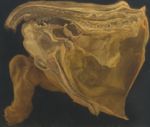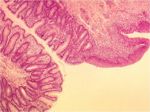Difference between revisions of "Rectum - Anatomy & Physiology"
Jump to navigation
Jump to search
m (Text replace - "Category:Alimentary System" to "Category:Alimentary System - Anatomy & Physiology") |
|||
| Line 66: | Line 66: | ||
| − | [[Category:Alimentary System]] | + | [[Category:Alimentary System - Anatomy & Physiology]] |
Revision as of 15:32, 31 August 2010
|
|
Introduction
The rectum lies between the terminal portion of the descending colon and anus. It is empty most of the time, except after the mass movements of the large intestine which move faeces into the rectum. This stimulates defeaction, which may happen when an animal is frightened.
Structure
- Exists dorsal to the reproductive organs, bladder and urethra.
- The cranial portion of the rectum is attached to the dorsal body wall by a short mesorectum which is a continuation of the mesocolon.
- The mesorectum is reflected to continue with the parietal peritoneum of the pelvic cavity and to cover the urogenital organs ventrally.
Function
Defeacation
- After the mass movements of the large intestine, the rectum becomes filled with faeces.
- This stimulates pressue sensitive cells in the wall of the rectum and initiates the defeacation reflex.
- The reflex causes a forceful contraction of the rectum, and relaxation of the internal anal sphincter.
- This produces the conscious sensation of the need to empty the bowel.
- Some species (see species differences) are able to voluntarily keep the external anal sphincter closed if defeacation is not suitable in the situation.
- This reduces the defeaction reflex and reduces the conscious perception of needing to empty the bowel, until another mass movement occurs and a fresh reflex is created.
Histology
Rectum
- Epithelium is columnar.
- Goblet cells are present in the mucosa.
Recto-Anal Junction
- Termination of the lamina muscularis and longitudinal layer of the tunica muscularis.
- The circular layer of the tunica muscularis forms the internal anal sphincter.
- The external anal sphincter is formed from skeletal muscle.
- Epithelium changes from columnar to stratified squamous non-keratinised.
Species Differences
Carnivore
- Control over the external anal sphincter is learned early in life.
- Defeaction reflex increased by contraction of the abdominal muscles and closure of the vocal cords to increase the pressure in the abdominal cavity.
Ruminant
- Appears to lack the ability to control the external anal sphincter.
Equine
- Appears to lack the ability to control the external anal sphincter.

